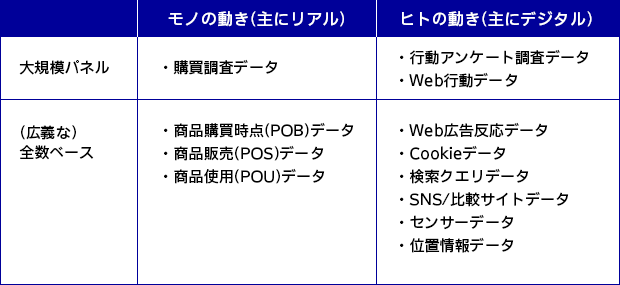Continuing from last time, we'll discuss the marketing application of sensor-derived data and its potential.
I believe sensor data is the very symbol of the big data era. While the "big data" era encompasses various types of data, data concerning "object movement" and "human movement" exists as either "large-scale panel data" or "complete data sets." Big data is the combination (integration) of this "object" and "human" movement data, and the new discoveries gained from this combination are precisely where the value of big data lies.

POU Data and Customer Experience Value Marketing
Within this context, sensor data can be described as data showing "comprehensive human movement." Historically, in marketing analysis, "product sales (Points of Sale: POS) data" has been a crucial comprehensive dataset. However, today, in addition to sales data, it has become possible to collect "product usage data (Points of Usage: POU)" from sensors embedded in products, showing how people actually use them.
By using this data to quantify the increasingly important "customer experience value" in real time and define clear metrics, we believe it becomes possible to provide actionable feedback to the business. While we won't delve into the details of customer experience value here, Gartner's finding that "89% of consumers will leave a company if their customer experience value is low" underscores the growing importance of mechanisms that use this POU data to "visualize" the experiences we provide customers through our products and services.
Such initiatives are by no means novel. For instance, a food manufacturer has been collecting data for over a decade by placing QR codes on product packaging lids that direct consumers to a special website. By measuring access times, they gather data on when consumers experience the product—whether at lunch, as a snack, or even as a late-night meal—and feed this back into product development.
Today, affordable network-connected devices and sensors can be embedded in products, primarily durable goods. This enables the collection of data 24/7/365 on where, when, how often, and for what purpose customers use and experience the product, facilitating easy feedback into business operations. Products like beds that capture sleep data and cars equipped with navigation systems that record driving history are already appearing in the market.
Furthermore, using this collected data, new business creation is expanding, such as developing new services within corporate domains and providing data to third-party entities.
We will share examples of how sensor data can be interpreted as customer experience value in a future post.
Big Data and Creativity
So, how can advertising agencies harness customer experience data, such as POU data generated by sensors, to create added value?
While consulting services for analyzing POU data itself and designing customer experience value management—from data generation to business feedback—are certainly part of the equation, advertising agencies can truly excel in the realm of "expression."
When designing communications tailored to customer experiences, "expression" is a crucial factor for maintaining an appropriate personal distance with customers and avoiding making them feel uncomfortable.
For example, as part of the omnichannel strategies retailers are pursuing, when implementing product recommendation initiatives via apps, rather than constantly pushing only "mechanically" generated recommendations based on past purchase history to customers' personal devices (smartphones), which can become annoying, sometimes deliberately deviating from their usual purchasing tendencies by delivering completely different product information can be effective. Alternatively, as part of the "stress-free shopping service" being experimentally introduced in physical stores, offering a "hospitality without hospitality" approach—refraining from the typical sales pitches common in commercial facilities—to customers wearing "Just Looking" bag charms is another possibility.
To strike the right personal distance with customers and create an appropriate sense of space, the creative power of "expression" is ultimately essential.
In the next installment, "What We Can See from the Trend of Business Alliances Between IT Vendors and Advertising Agencies," I'll supplement these ideas by discussing what is being demanded of advertising agencies.



